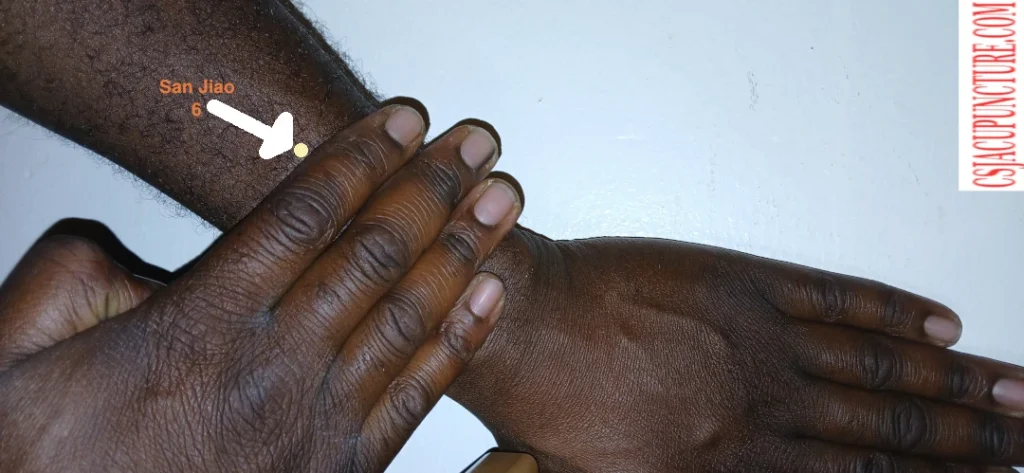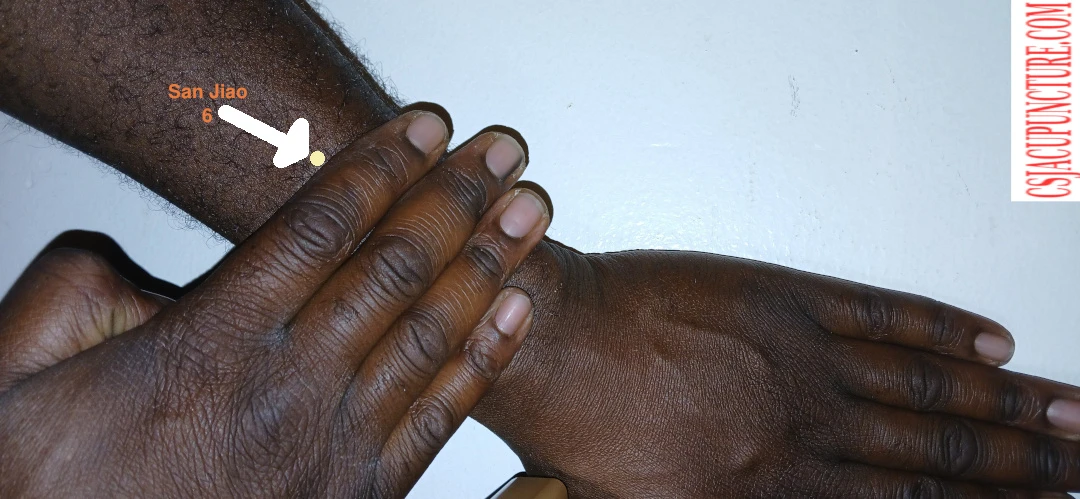This post may contain affiliate links and ads in which we may earn a small percentage of purchases.
Table of Contents
Let’s explore a point I frequently use in clinical practice – San Jiao 6 (SJ 6), also known as Zhigou. This point is quite versatile and effective in treatment, which is why it deserves special attention.
In this article, we’ll cover the basic functions of San Jiao 6 and examine its localized significance. We’ll also expand our discussion to consider its broader effects on the body.
Additionally, we’ll take a moment to introduce the San Jiao Meridian, an important pathway in Traditional Chinese Medicine (TCM), and discuss its role in overall health and function.
Overview of the San Jiao Meridian
The San Jiao Meridian is paired with the Pericardium Meridian, and this pairing plays a crucial role in TCM theory. The term San Jiao translates to “triple burner,” representing the three distinct sections of the body—the upper, middle, and lower burners (or jiao).
A clear and beginner-friendly guide covering over 400 acupuncture points, ideal for students and learners.
 View Book
View Book
A stainless-steel acupuncture pen and gua sha set for massage, reflexology, and tension relief.
 View Product
View Product
Each jiao governs different bodily functions:
- Upper Jiao: Involves the organs in the chest, such as the lungs and heart, and is responsible for respiration and circulation.
- Middle Jiao: Encompasses the digestive organs, focusing on the transformation and transportation of nutrients.
- Lower Jiao: Includes the organs in the lower abdomen, managing excretion and reproduction.
The San Jiao Meridian acts as a pathway for Qi and fluids to move freely through these three sections of the body. You can think of it as a highway that facilitates smooth energy flow throughout these areas.
This simplified explanation is just the beginning; we will dive deeper into the functions and dynamics of the San Jiao Meridian in future sections.
San Jiao 6 Point Location
San Jiao 6 is located 3 cun proximal to the dorsal wrist crease (SJ 4), between the radius and ulna, specifically between the tendons of extensor digitorum communis and extensor carpi ulnaris. This places it on the lateral (or radial) side of the forearm, which aligns with the side that performs supination (turning the palm upward).


Functions of San Jiao 6
San Jiao 6 traditionally holds indications for relieving constipation1, making it a potent Qi mover. Clinically, I employ SJ 6 for a wide variety of indications, beyond its typical use for digestive issues. One of its notable applications is for pain relief, particularly in conditions like carpal tunnel syndrome, wrist pain, tennis elbow, and lateral epicondylitis.
I also utilize this point in the treatment of de Quervain’s tenosynovitis, a condition that affects the tendons around the base of the thumb. Its versatility in addressing various types of hand and wrist pain, especially in cases involving inflammation and muscle tightness, makes it a valuable tool in pain management.
Pain Management and Muscle Relaxation
The muscles around the wrist can often become tight from frequent use, especially due to modern-day activities involving typing or repetitive wrist motions. SJ 6 is excellent for easing tension in these muscles, promoting relaxation, and reducing pain. Its ability to move Qi through the area helps alleviate discomfort and stiffness.
A Yin Point for Calming Effects
While SJ 6 is a powerful point for moving Qi, it is also categorized as a Yin point. For this reason, I often combine it with other Yin points when I aim to create a calming effect in patients, particularly in cases of emotional stress or internal tension. Though the effect may vary from patient to patient, I find that the balancing and calming properties of SJ 6 are useful in a wide range of treatments.
Coupled with Kidney 6 for Enhanced Effectiveness
Interestingly, SJ 6 is often paired with Kidney 6 (KD 6) to enhance its therapeutic effect. While SJ 6 primarily affects the external and Yang aspects of the body, Kidney 6, being a Yin point, addresses the internal or Yin-related conditions. The combination of these two points provides a more holistic approach to treatment, addressing both the external and internal needs of the patient.
A Point to Avoid During Pregnancy
Caution: I avoid using SJ 6 during pregnancy due to its strong Qi-moving capabilities. Its ability to move energy through the body could potentially disrupt the delicate balance required during pregnancy, so it’s essential to be mindful of when and where to apply this point.
Research on San Jiao 6
As of to date research is very limited on the acupuncture point, and the only studies that I found were a group of acupuncture points that included San Jiao 6.
A 2016 study published in Experimental and Therapeutic Medicine looked at transcutaneous acupoint electrical stimulation on the imbalance of Th and Treg cells following thoracotomy (a surgical procedure in which a cut is made between the ribs to see and reach the lungs or other organs in the chest or thorax)2 of patients with lung cancer. The study showed that “TAES was able to partially restore the postoperative immunosuppression of patients with lung cancer by altering the balance of Th1, Th2, Th17 and Treg cells, and their associated cytokines and transcription factors.”3
The information in this article is for educational purposes only. Please consult your primary care provider for any diagnosis or treatment.
- Nunez K. Pressure Points for Relieving Constipation. Healthline. Updated March 27, 2023. Reviewed by Boyle K, D.Ac., M.S., L.Ac., Dipl. Ac., CYT. https://www.healthline.com/health/pressure-points-for-constipation. Accessed September 23, 2024. ↩︎
- American Lung Association. What is a Thoracotomy? https://www.lung.org/lung-health-diseases/lung-procedures-and-tests/thoracotomy. Updated June 7, 2024. Accessed September 23, 2024. ↩︎
- Wu H, Wang K, Li G, et al. Effects of transcutaneous acupoint electrical stimulation on the imbalance of Th1, Th2, Th17 and Treg cells following thoracotomy of patients with lung cancer. Exp Ther Med. 2016;11(2):495-502. doi:10.3892/etm.2015.2913 ↩︎
Medical Disclaimer: This article is for informational and educational purposes only and is not a substitute for professional medical advice, diagnosis, or treatment. Always consult a qualified healthcare provider with any questions about a medical condition or treatment.




